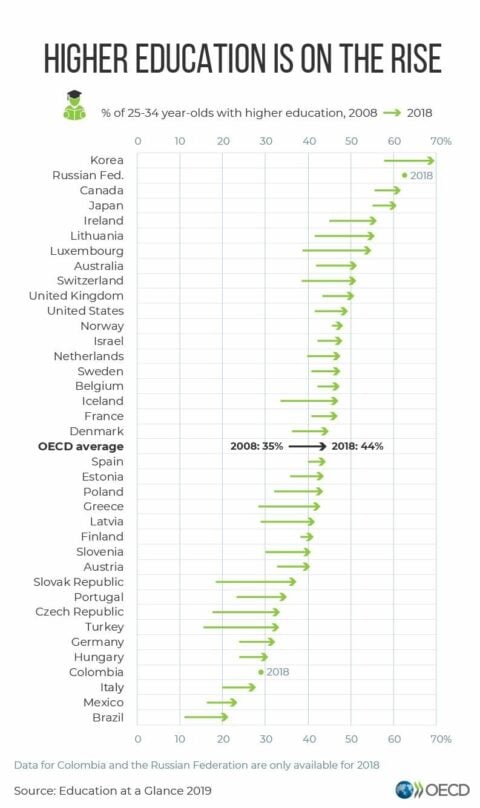Share Content
Article Link Copied
New OECD Report: Tertiary education is expanding

More students achieve a tertiary degree than ever before. In 2018 it was 44% of 25-34 year-olds in the OECD countries which is 9% more than in 2008. This is one of the good news highlighted by the newly published OECD report “Education at a Glance 2019”.
Tertiary education is more accessible than a decade ago, finds a new OECD report. On average across OECD countries, 44% of 25-34 year-olds held a tertiary degree in 2018, compared to 35% in 2008. On the other hand, spending on tertiary institutions between 2005 and 2016 increased at more than double the rate of student enrolments to about USD 15 600 per student on average.
However, some sectors in high demand may struggle to find the skills they need. Less than 15% of new bachelor students enroll in engineering, manufacturing and construction programs and less than 5% study information and communication technologies, despite these sectors having among the highest employment rates and earnings. Women are particularly under-represented, making up fewer than one in four entrants, on average, across OECD countries.
The newly published report from OECD “Education at a Glance 2019” provides many more comparable national statistics measuring the state of education worldwide. The report analyses the education systems of the OECD’s 36 member countries, as well as of Argentina, Brazil, China, Colombia, Costa Rica, India, Indonesia, the Russian Federation, Saudi Arabia and South Africa.

From the early childhood perspective, it is interesting that in almost all OECD countries the enrolment rate among 4-5 year-olds in education exceeded 90% in 2017. About one-third of countries achieve full enrolment for 3‑year‑olds. You can find more specific information on the topic in the chapter “How do early childhood education systems differ around the world?“.
Swiss specifics
The proportion of children aged 3 to 5 years enrolled in formal education are in Switzerland among the lowest of observed countries. The rates increased only slightly from 47% in 2005 to 50% in 2017 marking slow progress. However, the Swiss country report stipulates, that thanks to vocational programs, the employment rates for those with upper-secondary education are similar to those for tertiary degree holders highlighting the quality of vocational education in Switzerland.